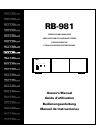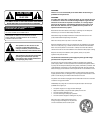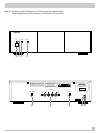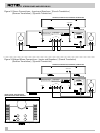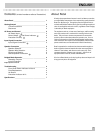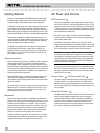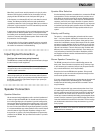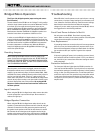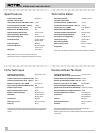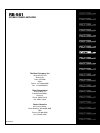
Speaker Wire Selection
Use insulated two-conductor stranded wire to connect the RB-981
to the speakers. The size and quality of the wire can have an au-
dible effect on the performance of the system. Standard speaker
wire will work, but can result in lower output or diminished bass
response, particularly over longer distances. In general, heavier
wire will improve the sound. For best performance, you may want
to consider special high-quality speaker cables. Your Rotel audio
retailer can help in the selection of appropriate cables for your
system.
Polarity and Phasing
The polarity — the positive/negative orientation of the connec-
tions — for every speaker and amplifier connection must be con-
sistent so all the speakers will be in phase. If the polarity of one
connection is mistakenly reversed, bass output will be very weak
and stereo imaging degraded. All wire is marked so you can iden-
tify the two conductors. There may be ribs or a stripe on the insu-
lation of one conductor. The wire may have clear insulation with
different color conductors (copper and silver). There may be po-
larity indications printed on the insulation. Identify the positive
and negative conductors and be consistent with every speaker
and amplifier connection.
Stereo Speaker Connection
6
The RB-981 has two pairs of color coded binding posts on the
back panel. These connectors accept bare wire, connector lugs,
or dual banana type connectors (except in the European Commu-
nity countries where their use is not permitted).
Route the wire from the RB-981 to the speakers. Give yourself
enough slack so you can move the components enough to allow
access to the speaker connectors.
If you are using dual banana plugs, connect them to the wires and
then plug into the backs of the binding posts. The hexagonal
thumbscrews of the binding posts should be screwed in all the
way (clockwise).
If you are using terminal lugs, connect them to the wires. If you
are attaching bare wires directly to the binding posts, separate
the wire conductors and strip back the insulation from the end of
each conductor. Be careful not to cut into the wire strands. Un-
screw (turn counterclockwise) the binding post hexagonal thumb-
screws. Place the connector lug around the binding post shaft, or
insert the bundled wire into the hole in the shaft. Turn the hexago-
nal thumbscrews clockwise to clamp the connector lug or wire
firmly in place.
Note:
Be sure there are no loose wire strands that could touch
adjacent wires or connectors.
Most likely, you will never see this protection circuitry in action.
However, should a faulty condition arise, the amplifier will stop
playing and the LED indicator on the front panel will light up.
If this happens, turn the amplifier off, let it cool down for several
minutes, and attempt to identify and correct the problem that
caused the protection circuitry to engage. When you turn the am-
plifier back on, the protection circuit will automatically reset and
the indicator LED should go out.
In most cases, the protection circuitry activates because of a fault
condition such as shorted speaker wires, or inadequate ventila-
tion leading to an overheating condition. In very rare cases, highly
reactive or extremely low impedance speaker loads could cause
the protection circuit to engage.
If the protection circuitry triggers repeatedly and you are unable
to isolate and correct the faulty condition, contact your Rotel au-
dio retailer for assistance in troubleshooting.
Input Signal Connection
5
[See Figure 2 for normal stereo wiring illustration.]
The RB-981 has conventional RCA type input connectors, the type
found on nearly all audio equipment.
Note: To prevent loud noises that neither you nor your speakers
will appreciate, make sure the amplifier is turned off when you
make any signal connections.
Select a high quality pair of audio interconnect cables. Connect
the left channel output of your preamp to the left channel input on
the RB-981. Connect the right channel output of your preamp to
the right channel input.
Speaker Connection
Speaker Selection
We recommend using loudspeakers with a nominal impedance of
4 ohms or higher with the RB-981. You should exercise some cau-
tion in driving multiple pairs of speakers in parallel configuration,
because the effective impedance the amplifier sees is cut in half.
For example, when driving two pair of 8 ohm speakers, the ampli-
fier sees a 4 ohm load. When driving multiple speakers in parallel,
it is recommended that you select speakers with a nominal imped-
ance of 8 ohms or higher. Speaker impedance ratings are less
than precise. In practice, very few loudspeakers will present any
problems for the RB-981. See your Rotel audio retailer if you have
any questions.
3
ENGLISH



